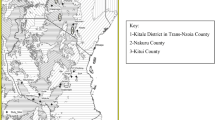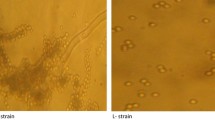Abstract
Aspergillus flavus and Aspergillus parasiticus cause perennial infection of agriculturally important crops in tropical and subtropical areas. Invasion of crops by these fungi may result in contamination of food and feed by potent carcinogenic aflatoxins. Consumption of aflatoxin contaminated foods is a recognised risk factor for human hepatocellular carcinoma (HCC) and may contribute to the high incidence of HCC in Southeast Asia. This study conducted a survey of Vietnamese crops (peanuts and corn) and soil for the presence of aflatoxigenic fungi and used microsatellite markers to investigate the genetic diversity of Vietnamese Aspergillus strains. From a total of 85 samples comprising peanut (25), corn (45) and soil (15), 106 strains were isolated. Identification of strains by colony morphology and aflatoxin production found all Vietnamese strains to be A. flavus with no A. parasiticus isolated. A. flavus was present in 36.0% of peanut samples, 31.1% of corn samples, 27.3% of farmed soil samples and was not found in virgin soil samples. Twenty-five per cent of the strains produced aflatoxins. Microsatellite analysis revealed a high level of genetic diversity in the Vietnamese A. flavus population. Clustering, based on microsatellite genotype, was unrelated to aflatoxin production, geographic origin or substrate origin.



Similar content being viewed by others
References
USDA Foreign Agricultural Service. World Agricultural Production. 2008. http://www.fas.usda.gov/.
Cotty PJ, Bayman P, Egel DS, Elias KS. Agriculture, aflatoxins and Aspergillus. In: Powell KA, Renwick A, Peberdy JF, editors. The genus Aspergillus: from taxonomy and genetics to industrial applications. New York: Plenum Press; 1994. p. 1–27.
Horn BW, Dorner JW. Soil populations of Aspergillus species from section Flavi along a transect through peanut-growing regions of the United States. Mycologia. 1998;90:767–76. doi:10.2307/3761317.
Pitt JI, Hocking AD. Fungi and food spoilage. 2nd ed. Gaithersburg: Aspen; 1997. p. 375–97.
Wicklow DT, Horn BW, Shotwell OL, Hesseltine CW, Caldwell RW. Fungal interference with Aspergillus flavus infection and aflatoxin contamination of maize grown in a controlled environment. Phytopathol. 1988;78:68–74. doi:10.1094/Phyto-78-68.
Wogan GN. Aflatoxins as risk factors for hepatocellular carcinoma in humans. Cancer Res. 1992;52:S2114–8.
Saracco G. Primary liver-cancer is of multifactorial origin—importance of hepatitis-B virus-infection and dietary aflatoxin. J Gastroenterol Hepatol. 1995;10:604–8. doi:10.1111/j.1440-1746.1995.tb01354.x.
Turner PC, Sylla A, Diallo MS, Castegnaro JJ, Hall AJ, Wild CP. The role of aflatoxins and hepatitis viruses in the etiopathogenesis of hepatocellular carcinoma: a basis for primary prevention in Guinea-Conakry, West Africa. J Gastroenterol Hepatol. 2002;17:S441–8. doi:10.1046/j.1440-1746.17.s4.7.x.
Parkin DM, Pisani P, Ferleay J. Estimates of the worldwide incidence of 25 major cancers in 1990. Int J Cancer. 1999;80:827–41. doi:10.1002/(SICI)1097-0215(19990315)80:6<827::AID-IJC6>3.0.CO;2-P.
Montalto G, Cervello M, Giannitrapani L, Dantona F, Terranova A, Castagnetta LAM. Epidemiology, risk factors, and natural history of hepatocellular carcinoma. Ann NY Acad Sci. 2002;963:13–20.
Lee N, Hill AS, Bui VT, Tran VA, Le VT, Kennedy IR. Monitoring mycotoxins and pesticides in grain and food production systems for risk management in Vietnam and Australia. In: Johnson GI, Le VT, Nguyen DD, Webb MC, editors. Quality assurance in agricultural produce. Canberra: ACIAR Proceedings 100; 2000. p. 496–500.
Cotty P. Strategies to reduce aflatoxin contamination. Phytopathology. 2008;98:S182–3. doi:10.1094/PHYTO.2008.98.6.S182.
Pitt JI, Hocking AD. Mycotoxins in Australia: biocontrol of aflatoxin in peanuts. Mycopathologia. 2006;162:233–43. doi:10.1007/s11046-006-0059-0.
Yin YN, Yan LY, Jian JH, Ma ZH. Biological control of aflatoxin contamination of crops. J Zhejian Univ Sci B. 2008;9:787–92. doi:10.1631/jzus.B0860003.
Shank RC, Wogan GN, Gibson JB. Dietary aflatoxins and human liver cancer. I. Toxigenic moulds in foods and foodstuffs of tropical South-East Asia. Food Cosmet Toxicol. 1972;10:51–60. doi:10.1016/S0015-6264(72)80046-4.
Siriacha P, Kawashima K, Kawasugi S, Saito M, Tonboon-Ek P. Postharvest contamination of Thai corn with Aspergillus flavus. Cereal Chem. 1989;66:445–8.
Pitt JI, Hocking AD, Bhudhasamai K, Miscamble BF, Wheeler KA, Tanboonek P. The normal mycoflora of commodities from Thailand 1. Nuts and oilseeds. Int J Food Microbiol. 1993;20:211–26. doi:10.1016/0168-1605(93)90166-E.
Pitt JI, Hocking AD, Bhudhasamai K, Miscamble BF, Wheeler KA, Tanboonek P. The normal mycoflora of commodities from Thailand 2. Beans, rice, small grains and other commodities. Int J Food Microbiol. 1994;23:35–53. doi:10.1016/0168-1605(94)90220-8.
Kumeda Y, Asao T, Takahashi H, Ichinoe M. High prevalence of B and G aflatoxin-producing fungi in sugarcane field soil in Japan: heteroduplex panel analysis identifies a new genotype within Aspergillus Section Flavi and Aspergillus nomius. FEMS Microbiol Ecol. 2003;45:229–38. doi:10.1016/S0168-6496(03)00154-5.
Pitt JI, Hocking AD, Glenn DR. An improved medium for the detection of Aspergillus flavus and A. parasiticus. J Appl Bacteriol. 1983;54:109–14.
Klich MA, Pitt JI. A laboratory guide to the common Aspergillus species and their teleomorphs. Sydney: Commonwealth Scientific and Industrial Research Organisation, Division of Food Processing; 1988.
Dyer SK, McCammon S. Detection of toxigenic isolates of Aspergillus flavus and related species on coconut cream agar. J Appl Bacteriol. 1994;76:75–8.
Tran-Dinh N, Pitt JI, Carter DA. Molecular genotype analysis of natural toxigenic, nontoxigenic isolates of Aspergillus flavus, A. parasiticus. Mycol Res. 1999;103:1485–90. doi:10.1017/S0953756299008710.
Tran-Dinh N, Carter DA. Characterisation of microsatellite loci in the aflatoxigenic fungi Aspergillus flavus and Aspergillus parasiticus. Mol Ecol. 2000;9:2170–2. doi:10.1046/j.1365-294X.2000.10539.x.
Minch E. MICROSAT version 1.4. Stanford: Stanford University Medical Center; 1996.
Saitou N, Nei M. The neighbour-joining method: a new method for reconstructing phylogenetic trees. Mol Biol Evol. 1987;4:406–25.
Fisher MC, Koenig GL, White TJ, Taylor JW. Pathogenic clones versus environmentally driven population increase: analysis of an epidemic of the human fungal pathogen Coccidioides immitis. J Clin Microbiol. 2000;38:807–13.
Ilic Z, Bui T, Tran-Dinh N, Dang MHV, Kennedy I, Carter D. Survey of Vietnamese coffee beans for the presence of ochratoxigenic Aspergilli. Mycopathologia. 2007;163:177–82. doi:10.1007/s11046-007-0099-0.
Ehrlich KC, Kobbeman K, Montalban BG, Cotty PJ. Aflatoxin-producing Aspergillus species from Thailand. Int J Food Microbiol. 2007;114:153–9. doi:10.1016/j.ijfoodmicro.2006.08.007.
Gao J, Liu Z, Yu J. Identification of Aspergillus section Flavi in maize in northeastern China. Mycopathologia. 2007;164:91–5. doi:10.1007/s11046-007-9029-4.
Takahashi H, Kamimua H, Ichinoe M. Distribution of aflatoxin-producing Aspergillus flavus and Aspergillus parasiticus in sugarcane fields in the southernmost islands of Japan. J Food Prot. 2004;67:90–5.
Sales AC, Yoshizawa T. Mold counts and Aspergillus section Flavi populations in rice and its by-products from the Philippines. J Food Prot. 2005;61:120–5.
Christensen M. A synoptic key and evaluation of species in the Aspergillus flavus group. Mycologia. 1981;73:1056–84. doi:10.2307/3759676.
Diener UL, Cole RJ, Sanders TH, Payne GA, Lee LS, Klich MA. Epidemiology of aflatoxin formation by Aspergillus flavus. Annu Rev Phytopathol. 1987;25:249–70.
Domsch KH, Gams W, Anderson TH. Compendium of soil fungi. London: Academic Press; 1980. p. 90–4.
Klich MA, Pitt JI. Differentiation of Aspergillus flavus from Aspergillus parasiticus and other closely related species. Trans Br Mycol Soc. 1988;91:99–108.
Viquez OM, Castellperez ME, Shelby RA, Brown G. Aflatoxin contamination in corn samples due to environmental conditions, aflatoxin-producing strains, and nutrients in grain grown in Costa Rica. J Agric Food Chem. 1994;42:2551–5. doi:10.1021/jf00047a033.
Barry D, Widstrom NW, Darrah LL, McMillan WW, Riley TJ, Scott GE, et al. Maize ear damage by insects in relation to genotype and aflatoxin contamination in preharvest maize grain. J Econ Entomol. 1992;85:2492–5.
Jones RK, Duncan HE. Effect of nitrogen fertiliser, planting date, and harvest date on aflatoxin production in corn inoculated with Aspergillus flavus. Plant Dis. 1981;65:741–4.
Setamou M, Cardwell KF, Schulthes F, Hell K. Aspergillus flavus infection and aflatoxin contamination of preharvest maize in Benin. Plant Dis. 1997;81:1323–7. doi:10.1094/PDIS.1997.81.11.1323.
Shearer JF, Sweets LE, Baker NK, Tiffany LH. A study of Aspergillus flavus/Aspergillus parasiticus in Iowa crop fields, 1989–1990. Plant Dis. 1992;76:19–22.
Davis ND, Diener UL. Biology of A. flavus and A. parasiticus, some characteristics of toxigenic and nontoxigenic isolates of Aspergillus flavus and Aspergillus parasiticus. In: Diener UL, Asuith RL, Dikens JW, editors. Aflatoxin and Aspergillus flavus in Corn. Auburn: Auburn University; 1983. p. 1–5.
Schroeder HW, Boller RA. Aflatoxin production of species and strains of the Aspergillus flavus group isolated from field crops. Appl Microbiol. 1973;25:885–9.
Geiser DM, Pitt JI, Taylor JW. Cryptic speciation and recombination in the aflatoxin-producing fungus Aspergillus flavus. Proc Natl Acad Sci USA. 1998;95:388–93. doi:10.1073/pnas.95.1.388.
O’Gorman CM, Fuller HT, Dyer PS. Discovery of a sexual cycle in the opportunistic fungal pathogen Aspergillus fumigatus. Nature advance online publication 30 November 2008 (DOI 10.1038/nature07528).
Rodriguez-del-Bosque LA. Impact of agronomic factors on aflatoxin contamination in preharvest field corn in Northeastern Mexico. Plant Dis. 1996;80:988–93.
Rustom IYS. Aflatoxin in food and feed: occurrence, legislation and inactivation by physical methods. Food Chem. 1997;59:57–67. doi:10.1016/S0308-8146(96)00096-9.
FAO/WHO. Forty-ninth report of the joint FAP/WHO expert committee of food additives: evaluation of certain food additives and contaminants. Who Tech Rep Ser. 1999;884:69–77.
Acknowledgments
This study was made possible by monies provided by a collaborative Australian Centre for International Agricultural Research (ACIAR) project detecting mycotoxins in Vietnamese crops, which is gratefully acknowledged. We thank our Vietnamese colleagues, Dr. T. V. Le, Dr. A. V. Tran, Dr. D. V. H. Mien (Post-Harvest Technology Institute, Ho Chi Minh City, Vietnam), Dr. T. T. Phan (Department of Veterinary Medicine, College of Agriculutre, Cantho University, Cantho, Vietnam), Dr. Truong V. Bui (Faculty of Food Safety and Nutrition, Institute of Hygiene and Epidemiology, Buon Ma ThuotCity, Vietnam) and Dr. N. K. Van and Dr. H. T. Nguyen (Department of Plant Pathology and Agro-Pharmacology, Hanoi Agricultural University No. 1, Hanoi, Vietnam) for their assistance in collecting samples.
Author information
Authors and Affiliations
Corresponding author
Rights and permissions
About this article
Cite this article
Tran-Dinh, N., Kennedy, I., Bui, T. et al. Survey of Vietnamese Peanuts, Corn and Soil for the Presence of Aspergillus flavus and Aspergillus parasiticus . Mycopathologia 168, 257–268 (2009). https://doi.org/10.1007/s11046-009-9221-9
Received:
Accepted:
Published:
Issue Date:
DOI: https://doi.org/10.1007/s11046-009-9221-9




